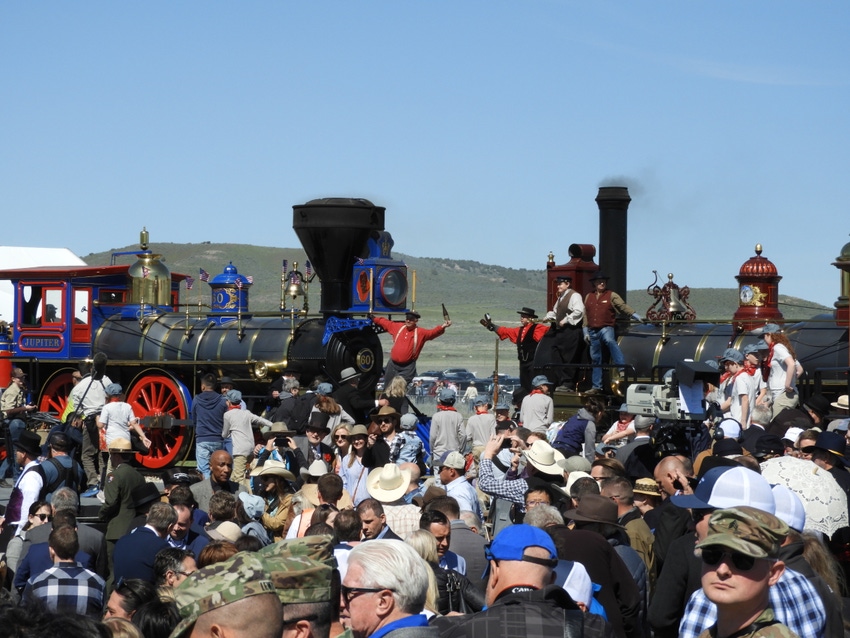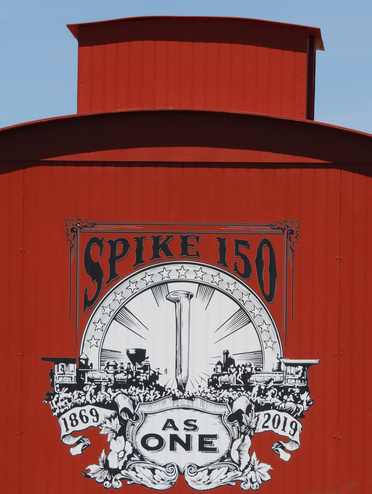Big ideas and big dreams are the stuff of the best of American history. And in that history lies our hope.
May 29, 2019

Editor’s Note—Occasionally, it’s important to remember our past. Here’s an article about a truly historic event for the entire nation and particularly for the cattle business. Enjoy.
Fully 150 years ago, one of the biggest infrastructure projects ever attempted up to that point in history was completed. At Promontory Summit, Utah, the last spike was driven in the Transcontinental Railroad, an artery that would enable trade and travel between America’s East and West like never before.
A trip from the East Coast to the West Coast would soon take a week where not long before it took six months. The future was coming at the speed of…well, a steam locomotive.
On May 10, 2019, the Golden Spike commemoration celebration was held where the momentous day was re-enacted, while dignitaries and some estimated 15-20,000 spectators looked on. The spot is now the Golden Spike National Historic Park.
The attendees at the 2019 reenactment didn’t do the heavy lifting that most of the estimated 500 original attendees did 150 years ago to earn their place at the ceremony. Nonetheless, the 2019 crowd could not contain the same patriotic pride and exuberance at the significance of the event that the original attendees surely felt. The Utah governor, cabinet officials and other dignitaries gave speeches, a Chinese diplomat send a video and the Irish ambassador gave a toast.
It’s hard to know how much pride the workers building the road felt at the time, but it is certain their descendants and citizens today appreciate and recognize the significance of their accomplishment. Much was made of the labor supplied by Chinese immigrants on the Central Pacific, as well as the Irish, Civil War veterans from both the Confederate and Union armies, newly freed slaves and other immigrants making up the construction crews on the Union Pacific. As construction neared Utah, the Church of Latter Day Saints provided grading crews and labor to both the Central Pacific and the Union Pacific.
Descendants of those who’s sweat built the railroad were honored on stage. A representative of the native tribes whose lands were forever changed offered a prayer.
Ranching reimagined
The railroad had a huge impact on farmers and ranchers in the West, as they acquired markets for their livestock and produce never before attainable. They also could get supplies faster and at lower costs than ever before. Instead of driving herds to Dodge City or the closest railhead, they could ship on the railroad directly to Kansas City or Chicago from points west.
The first refrigerated railcar was patented in 1867 but it took fits and starts of innovation for some years, until Swift in 1881 was shipping 3,000 carcasses a week from the packing industry’s core in Chicago to Boston.
Secretary of Transportation lends perspective
“As the first U. S. Secretary of Transportation of Chinese ancestry, I have the unique and moving opportunity to fully acknowledge and recognize the contributions and sacrifices of the laborers of Chinese heritage to the construction of the transcontinental railroad,” Secretary Elaine Chao said. She added that of the 15,000 Central Pacific workers, 12,000 were Chinese.
“The Chinese workers blasted and chiseled their way through the rugged Sierra Nevada mountains. Using manual hammer drills, pick axes and explosives, they dug 15 tunnels through hard granite.
“The Transcontinental Railroad was a tremendous feat of engineering, innovation and manpower that was key to unleashing the economic prosperity of the United States for generations,” Chao said.
The act of building the transcontinental railroad was transformational, she added.
“The government provided land and other resources to encourage private sector investment in the railroads. Innovation and planning guided the project. Standard gauge track was adopted on a national basis. Telegraph lines were built along the track right of way. Nitroglycerin gradually replaced less powerful black powder when blasting tunnels through the Sierra mountains. The railroad workers became so skilled that a legendary team of workers built 10 miles of track in a single day.”
Historical reflections
Historian and author Jon Meacham gave the keynote address, reflecting on the meaning of the Transcontinental Railroad, including parallels and contrasts to our world today.

He noted Lincoln’s signing the authorizing legislation in 1862 amid the Civil War, “a thought of the future amid the storms of the present. The Transcontinental Railroad stands even now as an emblem of American boldness, and of American union,” he said.
He gave a note of optimism and confidence, quoting Winston Churchill:
“You can always count on the Americans to do the right thing…once they have exhausted every other possibility.”
The railroad made possible a continent that would bring together what Jefferson called the “empire of liberty. The nation was united here…in fact.”
“We stand, therefore, on a kind of sacred ground,” Meacham continued. “The story of the Transcontinental Railroad is the story of America.”
“We--you and I--are caught in a moment of public dispiritedness, of reflexive partisanship, and of a broad distrust of the future.
“This is a good moment and a good place to reflect on who we’ve been, who we are and where we might go in the next 150 years.
“It’s especially significant that we’re here at this particular moment in the life of our nation. For many of the elements so essential to the conception and to the realization of this vast project seem all too elusive in our own time.
“If the men and women of the past, with all their flaws and limitations…could press on…to form a more perfect union …then perhaps we, too… can leave things better than we found them.
“Still, I would argue that history has the capacity to bring us together. For our story, for all of its faults, is ultimately the story of obstacles overcome, of crises resolved, of freedom expanded.”
What can we learn from the past, Meacham asked? That perfect should not be the enemy of the good.
The visionaries and the workers of 150 years ago knew that “a nation connected might just be a nation unified.” The powerful in government and commerce worked with the powerless, the immigrant laborers like the Chinese and the Irish and other countries, to build a railroad.
“The work of America is not done. In many ways, the American Revolution unfolds still. That’s our blessing and our burden.
“The Transcontinental project was shaped by sectionalism, by battles for power, by party politics, by slavery and freedom. And yet our forebears delivered.
“Let’s not indulge ourselves in the narcissism of the present, and act as though our problems are more insufferable that anything that ever confronted any previous generation.
“For all our unhappiness, what is our immigration issue in this country? Our immigration issue is that people want to come here.
“If Americans want to know what is possible, come here.” Our leaders of the past had “faith founded on the conviction that tomorrow can be better than today. If you want to know how that “faith can find tangible expression, come here.”
“Big ideas and big dreams are the stuff of the best of American history. And in that history lies our hope.”
Dittmer is a longtime beef industry commentator and executive vice president of the Agribusiness Freedom Foundation.
About the Author(s)
You May Also Like



.png?width=300&auto=webp&quality=80&disable=upscale)
.png?width=300&auto=webp&quality=80&disable=upscale)
